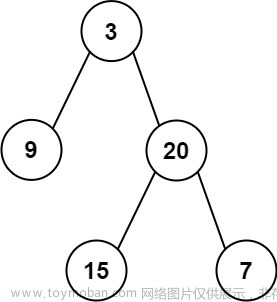
此篇皆为leetcode、牛客中的简单题型和二叉树基础操作,无需做过多讲解,仅付最优解。有需要的小伙伴直接私信我~
目录
1.二叉树的节点个数
2.二叉树叶子节点个数
3.二叉树第K层节点个数
4.查找值为X的节点
5.leetcode——二叉树的最大深度
6.leetcode——单值二叉树
7.leetcode——相同的树
8.二叉树的前序遍历
9.二叉树的中序遍历
10.二叉树的后序遍历
11.二叉树的层序遍历
12.leetcode——另一棵树的子树
13.二叉树的构建及遍历
14.leetcode——对称二叉树
1.二叉树的节点个数
int BinaryTreeSize(BTNode* root)
{
return root == NULL ? 0 :
BinaryTreeSize(root->left) +
BinaryTreeSize(root->right) + 1;
}2.二叉树叶子节点个数
int BinaryTreeLeafSize(BTNode* root)
{
if (root == NULL)
return 0;
if (root->left == NULL && root->right == NULL)
return 1;
return BinaryTreeLeafSize(root->left) + BinaryTreeLeafSize(root->right);
}3.二叉树第K层节点个数
int BinaryTreeLevelKSize(BTNode* root, int k)
{
if (root == NULL)
return 0;
if (k == 1)
return 1;
return BinaryTreeLevelKSize(root->left, k - 1) +
BinaryTreeLevelKSize(root->right, k - 1);
}
4.查找值为X的节点
BTNode* BinaryTreeFind(BTNode* root, BTDataType data)
{
if (root == NULL)
return NULL;
if (root->data == data)
return root;
BTNode* ret1 = BinaryTreeFind(root->left, data);
if (ret1)
return ret1;
BTNode* ret2 = BinaryTreeFind(root->right, data);
if (ret2)
return ret2;
return NULL;
}5.leetcode——二叉树的最大深度
oj链接:二叉树的最大深度
int maxDepth(struct TreeNode* root) {
if (root == NULL)
return 0;
int leftDepth = maxDepth(root->left);
int rightDepth = maxDepth(root->right);
return (leftDepth > rightDepth ? leftDepth : rightDepth) + 1;
}6.leetcode——单值二叉树
oj链接:单值二叉树
bool isUnivalTree(struct TreeNode* root)
{
if (root == NULL)
{
return true;
}
if (root->left && root->val != root->left->val)
return false;
if (root->right && root->val != root->right->val)
return false;
return isUnivalTree(root->left) && isUnivalTree(root->right);
}7.leetcode——相同的树
oj链接:相同的树
bool isSameTree(struct TreeNode* p, struct TreeNode* q) {
if (p == NULL && q == NULL)
return true;
if (p == NULL || q == NULL)
return false;
if (p->val != q->val)
{
return false;
}
return isSameTree(p->left, q->left) && isSameTree(p->right, q->right);
}
8.二叉树的前序遍历
详细讲解:二叉树的前、中、后序遍历
void PrevOrder(BTNode* root)
{
if (root == NULL)
{
printf("NULL ");
return;
}
printf("%d ", root->data);//前序在前
PrevOrder(root->left);
PrevOrder(root->right);
}9.二叉树的中序遍历
void InOrder(BTNode* root)
{
if (root == NULL)
{
printf("NULL ");
return;
}
InOrder(root->left);
printf("%d ", root->data);//中序在中
InOrder(root->right);
}10.二叉树的后序遍历
void PostOrder(BTNode* root)
{
if (root == NULL)
{
printf("NULL ");
return;
}
PostOrder(root->left);
PostOrder(root->right);
printf("%d ", root->data);//后序在后
}11.二叉树的层序遍历
详细讲解:看完这篇我不信你不会二叉树的层序遍历
//需自己实现队列的数据结构
void BinaryTreeLevelOrder(BTNode* root)
{
Queue q;
QueueInit(&q);
if (root)
QueuePush(&q, root);
else
return;
while (!QueueEmpty(&q))
{
BTNode* front = QueueFront(&q);
printf("%d ", front->data);
QueuePop(&q);
if(front->left)
QueuePush(&q, front->left);
if(front->right)
QueuePush(&q, front->right);
}
printf("\n");
QueueDestroy(&q);
}12.leetcode——另一棵树的子树
oj链接:另一棵树的子树
//判断两树是否相同(复用“相同的树”解题代码)
bool isSametree(struct TreeNode* p,struct TreeNode* q)
{
if(p==NULL && q==NULL)
return true;
if(p==NULL || q==NULL)
return false;
if(p->val != q->val)
return false;
return isSametree(p->left,q->left) && isSametree(p->right,q->right);
}
bool isSubtree(struct TreeNode* root, struct TreeNode* subRoot){
if(root==NULL)
return false;
if(isSametree(root,subRoot))
return true;
return isSubtree(root->left,subRoot) || isSubtree(root->right,subRoot);
}13.二叉树的构建及遍历
题目链接:二叉树的遍历
注意:本题虽然是二叉树的遍历,但考查的却是如何通过数组的内容构建一棵二叉树。文章来源:https://www.toymoban.com/news/detail-790953.html
#include <stdio.h>
#include <stdlib.h>
struct TreeNode {
int val;
struct TreeNode *left;
struct TreeNode *right;
};
struct TreeNode* rebuildTree(char* str,int* pi)
{
if(str[*pi] == '#')
{
(*pi)++;
return NULL;
}
struct TreeNode* root = (struct TreeNode*)malloc(sizeof(struct TreeNode));
root->val = str[(*pi)++];
root->left = rebuildTree(str,pi);
root->right = rebuildTree(str,pi);
return root;
}
void TreeDestory(struct TreeNode* root)
{
if(root==NULL)
return;
TreeDestory(root->left);
TreeDestory(root->right);
free(root);
}
void InOrder(struct TreeNode* root)
{
if (root == NULL)
{
return;
}
InOrder(root->left);
printf("%c ", root->val);
InOrder(root->right);
}
int main() {
char str[100];
scanf("%s",str);
int i=0;
struct TreeNode* root = rebuildTree(str,&i);
InOrder(root);
TreeDestory(root);
return 0;
}14.leetcode——对称二叉树
oj链接:对称二叉树文章来源地址https://www.toymoban.com/news/detail-790953.html
bool _isSymmetric(struct TreeNode* p, struct TreeNode* q)
{
if (p == NULL && q == NULL)
return true;
if (p == NULL || q == NULL)
return false;
if (p->val != q->val)
return false;
return _isSymmetric(p->left, q->right) &&
_isSymmetric(p->right, q->left);
}
bool isSymmetric(struct TreeNode* root) {
return root == NULL ? 0 : _isSymmetric(root->left, root->right);
}到了这里,关于二叉树经典14题——初学二叉树必会的简单题的文章就介绍完了。如果您还想了解更多内容,请在右上角搜索TOY模板网以前的文章或继续浏览下面的相关文章,希望大家以后多多支持TOY模板网!













